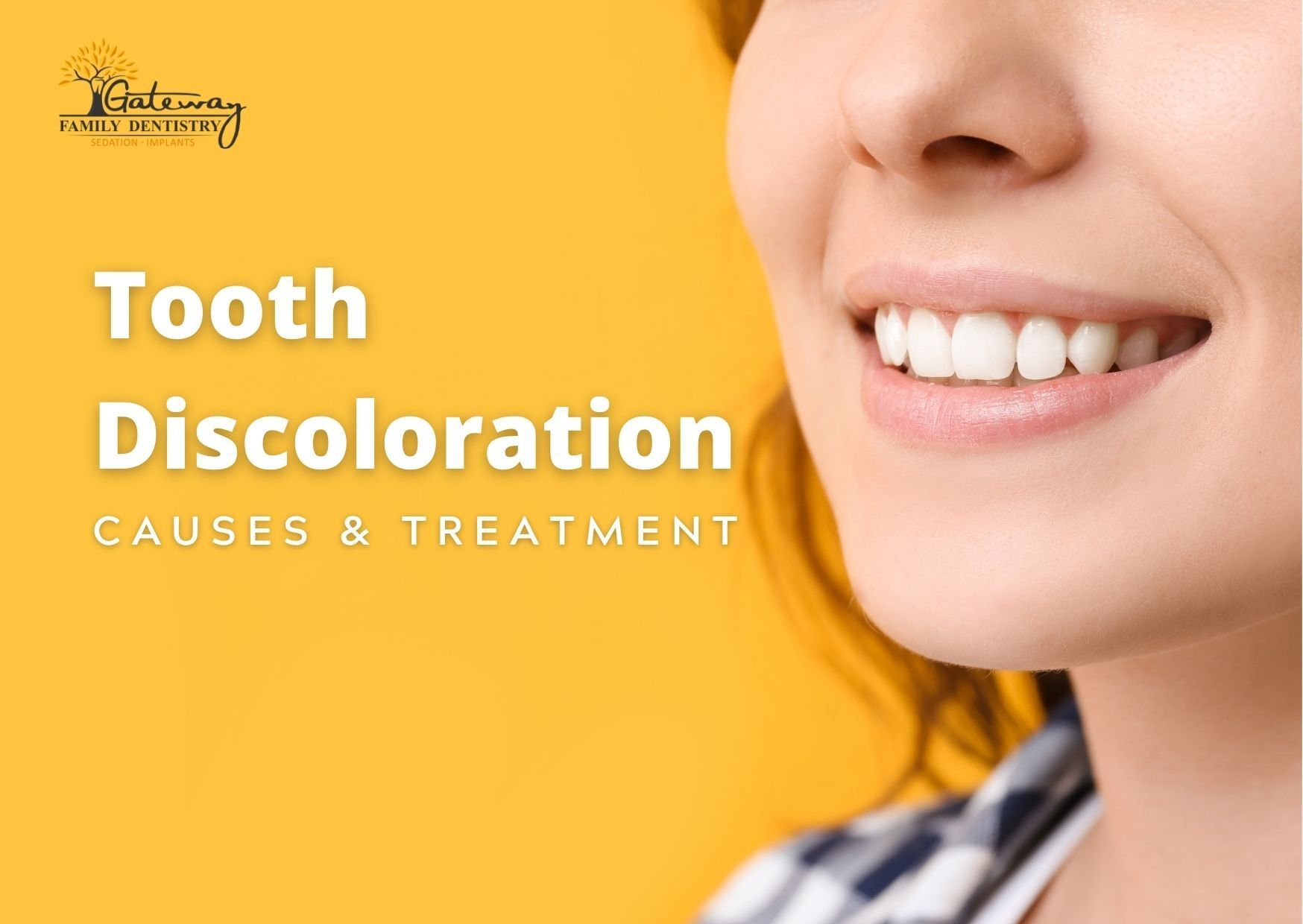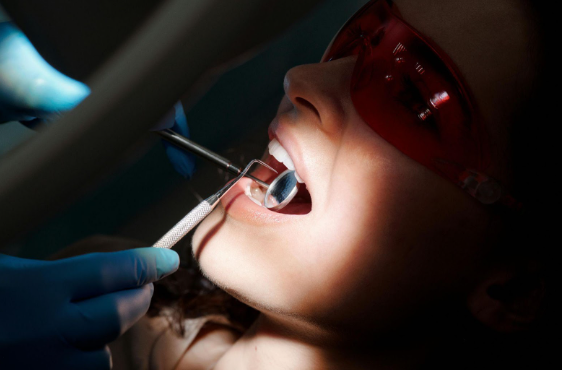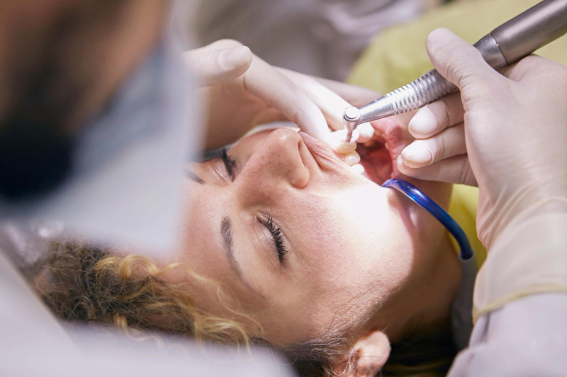Gateway Family Dental Blog
Everything You Need to Know About Tooth Discoloration

Have you ever noticed the color of your teeth changing? Maybe they’re less white than they used to be or have developed a yellow hue. Tooth discoloration and stains are common occurrences that can be caused by a variety of reasons. But don’t despair—most of these stains are treatable and preventable.
Keep reading to learn more about tooth discoloration, and what you can do to keep your smile looking its best.
What Is Tooth Discoloration?
Tooth discoloration is a change in the color of your teeth. They may look less bright and white or may turn yellow. They may even develop white or dark spots in certain places. Tooth discoloration can have several causes: extrinsic (outside the body), intrinsic (inside the body), or age-related.
What Causes Yellow Teeth near the Gum Line?
Many people notice that their teeth are more yellow near the gum line than the tips of their teeth. While a yellow hue near the gum line can be an early sign of tooth decay, gum disease, and other dental problems—it is usually an indication of dental plaque or tartar.
Dental plaque develops due to bacteria in the mouth combined with food byproducts and proteins. The accumulation of plaque can cause it to harden into tartar. Tartar is quite common, with 68% of adults in the United States having it.
While dental plaque can be removed or lessened by lifestyle changes or dental treatments, tartar is much harder to remove and must be done by a dental professional. If you find a yellow color near your gum line, it’s a telltale sign of tartar buildup, so contact a dentist to have it removed.
Causes of Tooth Discoloration
There are several causes of tooth discoloration, including:
Lifestyle
One of the main reasons behind tooth discoloration is food and drinks. A large intake of coffee, tea, colas, starchy foods like pasta and potatoes, red sauces, red wines, and chocolate can all commonly cause tooth discoloration.
There is also a higher prevalence of tooth discoloration in smokers over non-smokers due to tobacco.
Aging
Aging causes the outer layer of enamel on your teeth to slowly get worn away. This exposes the dentin—the yellowish tissue that makes up the bulk of teeth—and can make the teeth a lot more vulnerable to damage and decay.
Poor Dental Hygiene
Not brushing or flossing your teeth regularly is a major cause of the buildup of plaque and tartar in the teeth and gums. It’s especially important to clean your teeth after consuming pigmented foods and drinks, but if it’s not possible to brush or floss after, make sure to rinse your mouth.
Disease
Diseases that prevent the natural development of enamel and dentin can cause tooth discoloration. Additionally, some treatments like radiation and chemotherapy for the head and neck can lead to discoloration in the teeth.
Medication
Certain medications like tetracycline and doxycycline can cause discoloration in teeth when given to children, especially children below the age of 8 since they can affect the formation of enamel. Antihistamines like Benadryl, antipsychotic drugs, and antihypertensive medication can also cause tooth discoloration.
Additionally, mouthwashes and rinses containing chlorhexidine and cetylpyridinium chloride can cause stains on the teeth.
Genetics
Some families have naturally thicker and brighter enamel than others, while some families are prone to tooth discoloration. Depending on the discoloration experienced by your family, you can take extra preventive measures to protect your teeth.
Environmental Factors
Environmental factors can play a role in tooth discoloration, especially during the formation of teeth. For example, excessive fluoride exposure from naturally high fluoride levels in water or fluoride applications, toothpaste, and rinses can lead to fluorosis, which causes mild to severe discoloration of the teeth.
How to Remove Stains on Teeth?
There are many treatment options available to whiten your teeth. Not everyone can be a candidate for every whitening method but depending on your level of staining and discoloration, there are several treatment methods you can try.
Note: Dental restorations like bonding, veneers, crowns, bridges, dentures, and implants cannot be whitened, since they are made of manmade materials and not enamel.
At-Home Treatment
● Prevention. The best form of treatment is prevention. Avoiding food and drinks with stain markers is one of the best preventative measures you can take. If you cannot avoid these foods, make sure to brush, floss, or rinse after.
● Over-the-counter products. Whitening toothpaste and strips might reduce the stains on the surface of your teeth but likely will not affect any intrinsic stains. Talk to your dentist before using any teeth whitening products to make sure it’s safe.
● Practicing good dental hygiene. Try to get into a habit of brushing and flossing thoroughly at least twice a day, and rinsing after each meal. If you notice any yellowing or reduction in the appearance of your teeth, improving your dental hygiene can help manage or even reverse some of these effects.
Professional Treatment
● Professional whitening. Professional whitening is an in-office service to speed up the teeth whitening process. Dentists will usually use a higher concentration of hydrogen peroxide, and some products may require the application of heat with a special light to further accelerate the whitening.
Some dentists also make custom trays to wear on your teeth for up to an hour a day or as otherwise recommended by your dentist. These trays have a gel for better whitener adhesion. You may be required to wear them for a few weeks for the best results.
● Dental procedures. Dental procedures like dental crowns, dental veneers, and dental bonding are commonly used to help whiten teeth. Dental crowns are placed over damaged or discolored teeth, while dental veneers cover the front of your teeth to improve your smile. Dental bonding involves applying a white resin to your teeth which are then hardened with a special light.
Tips to Prevent Tooth Discoloration
There are a few simple lifestyle changes you can make that will help you prevent tooth discoloration.
● Brush and floss.
● Drink water.
● Use a (reusable) straw.
● Quit smoking.
● Get regular dental checkups.
Your smile is an asset, so you must take the time to protect it. At Gateway Family Dentistry, we offer professional teeth whitening services even for the most persistent stains. We’d love to keep you smiling in the years to come, so contact us today!




